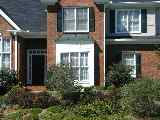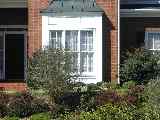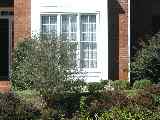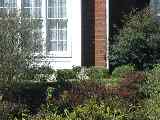Olympus D-490 ZoomOlympus updates a popular 1.3 megapixel model to 2 megapixels, with improved features.<<Reference: Datasheet :(Previous) | (Next): Print-Friendly Review Version>> D-490 Sample ImagesReview First Posted: 10/28/2000 |
| We've begun including links in our reviews to a Thumber-generated index page for our test shots.
The Thumber data includes a host of information on the images, including
shutter speed, ISO setting, compression setting, etc. Rather than clutter
the page below with *all* that detail, we're posting the Thumber index so
only those interested in the information need wade through it!
;) |
|
|
Outdoor
portrait: (1340k) The extreme tonal range of this image makes it a tough shot for many digicams, which is precisely why we set it up this way. The object is to hold highlight and shadow detail without producing a "flat" picture with muddy colors, and the Olympus D490's handles the challenge fairly well. We shot samples of this image in both the automatic (1340k) and daylight (1340k) white balance modes, choosing the daylight setting for our main series (the automatic setting produced slightly cool results). Actually, the daylight setting looks just a little reddish, but the white of the shirt seems more accurate. Color balance looks pretty good throughout the rest of the image, as the blue flowers and pants look about right. These blues are somewhat difficult for many digicams to reproduce correctly. There's a slight "glow" around the bright red flower where it comes against the blue Iris. Red/Blue artifacts of this sort are fairly common in digicams, because of how the CCD color filters are arranged. It's nearly impossible to avoid them entirely, but the 490 shows the problem a bit more than we'd like to see. Resolution looks pretty good, though slightly soft, with a fair amount of fine detail visible in the model's hair and in the flowers. The shadow areas also hold a nice level of detail, with a moderate amount of noise present. Our main image was taken with a +1.0 EV exposure adjustment, which did the best job of adequately exposing the skin tones and shadow areas although the result was that the strong highlights of the shirt were rather badly blown out. The table below shows the results of a range of exposure settings from zero to +1.5 EV in the daylight white balance mode. Exposure Compensation Settings:
|
||||||||||||||||||||
|
|
Closer
portrait: (1079k) The D490 also does a nice job with this closer, portrait shot, without any visible distortions from its 3x lens. (Shorter focal length lenses tend to distort facial features in close-up shots like this and the availability of longer focal lengths is a key feature if you're going to be shooting close-up people shots.) We again shot with the daylight white balance setting, requiring no exposure adjustment for our main image. (This close-up shot generally requires less exposure compensation than the wider Outdoor Portrait.) Resolution looks better here, with more defined details visible, especially in the strands of the model's hair and in the wood grain pattern of the house siding. A moderate level of noise remains present in the deep shadows. The table below shows the results of a range of exposure settings, from zero to +1.5 EV. Exposure Compensation Settings:
|
||||||||||||||||||||
|
|
Indoor
Portrait, Flash: (745k) The D490's built-in flash does a pretty good job of illuminating the subject, though a rather warm, orange color cast is present from the strong incandescent lighting in the room. Notably though, there are none of the bluish highlights we often encounter in this flash test, caused by a mismatch between the color of the flash and the room lighting. For our main image, we used a +1.0 EV adjustment. Despite the orange cast, color balance is pretty good on the model's face and in the flowers. The blue flowers are a little light, but the tone still looks good. (Overall, one of the better performances we've seen on this shot.) Next, we shot with a slower shutter speed and a +0.5 EV adjustment, which produced this (718k) more evenly lit image. Though the lighting appears smoother and less harsh, the warm, orange cast is increased, throwing the color balance way off on the subject. We also snapped an image with the camera's Red-Eye Reduction (718k) flash mode, which produced a bright, white reflection in one eye, with none in the other. The table below shows a range of flash exposures with exposure compensation adjustments from zero to +1.5 EV. Exposure Compensation Settings:
|
||||||||||||||||||||
|
|
Indoor
portrait, no flash: (1380k) This shot is always a very tough test of a camera's white balance capability, given the strong, yellowish color cast of the household incandescent bulbs used for the lighting, and the D490's white balance system does a really great job. We tested the automatic (654k) and incandescent (744k) white balance settings, choosing the automatic setting for our main series. The incandescent setting produced a very warm, almost sepia, image. Color balance looks good under the automatic white balance setting, though the red and yellow flowers appear a undersaturated, and the overall image has a bit of a "milky" look to it. The model's skin tones and hair color also look a little undersaturated, but overall, the color balance is surprisingly good. (The significant majority of digicams tend to produce a very yellowish cast on this subject.) For our main shot, we chose a +1.5 EV adjustment, as it obtained the best exposure overall. We also tested the camera's variable ISO settings, shooting at the 100,(751k) 200 (1100k) and 400 (955k) ISO equivalents. Brightness remained about the same at each of the sensitivity settings, but noise level increased quite noticeably with the 200 and 400 settings (the 100 ISO setting produces only moderate noise). In our opinion, the noise level at 200 is pretty acceptable for average subjects, but we'd only recommend the ISO 400 setting for situations were it was the only alternative for getting the shot. The table below shows a range of exposure adjustments from zero to +2.0 EV, using the D490's automatic white balance setting. Exposure Compensation Settings:
|
||||||||||||||||||||
|
|
House
shot: (960k) NOTE that this is the "new" house shot, a much higher-resolution poster than we first used in our tests. To compare the image of the D490 with previously tested cameras, here's a shot of the original house poster in the automatic (978k) white balance setting. We shot samples of this image with the automatic,(71k) daylight, (71k) and fluorescent (71k) white balance
modes, selecting the automatic setting as the most accurate. The daylight
setting resulted in a warm image, while the fluorescent setting produced
slightly magenta results. The image is a little soft overall, but detail
still looks pretty good. A lot of fine detail is visible in the tree
limbs, shrubbery, and bricks, as well as in other aspects on the house
front. Noise is moderate in the roof shingles, and the in-camera
sharpening is barely detectable (we just picked up maybe half a pixel of a
halo effect around the light and dark edges of the white trim along the
roof line). Overall, not the sharpest 2 megapixel camera we've tested, but
then it's far from the worst, and likewise far from the most expensive.
The table below shows the full range of resolution and quality settings
for the D490, all in the automatic white balance mode.
|
||||||||||||||||||||
|
|
Far-Field
Test (1229k) This image is shot at infinity to test far-field lens performance. NOTE that this image cannot be directly compared to the other "house" shot, which is a poster, shot in the studio. The rendering of detail in the poster will be very different than in this shot, and color values (and even the presence or absence of leaves on the trees!) will vary in this subject as the seasons progress. In general though, you can evaluate detail in the bricks, shingles and window detail, and in the tree branches against the sky. Compression artifacts are most likely to show in the trim along the edge of the roof, in the bricks, or in the relatively "flat" areas in the windows. We shot this image using the automatic white balance mode, as that
produced the most accurate white value. Color balance looks very nice,
though the red tones seem slightly undersaturated when compared to the
blue sky and green grass. This shot is a strong test of detail, given the
practically infinite range of fine detail viewable in a natural scene like
this. Resolution is just slightly soft, but there's still a good amount of
detail visible in the pine needles and tree branches against the sky, as
well as in the bricks and shrubbery. Resolution overall on this shot is
fairly typical of 2 megapixel digicams we've tested. We also judge a
camera's dynamic range in this shot, comparing how well the camera holds
detail in both the shadow and highlight areas. The D490 does a reasonably
good job here, though it loses all but the most evident details of the
bright bay window area. However, the shadow areas show good detail,
specifically in the dark area beneath the cherry tree on the right side of
the house and in the darker shadows of the woods. A moderately high amount
of noise is visible in the roof shingles. We shot another series of images
at the 100,(1234k) 200 (1324k) and 400 (1049k) ISO settings.
Unlike our last ISO series, we noticed that the increased ISO levels did
brighten the image, as well as increase the noise level. We also shot with
the D490's soft (1116k)
setting, which seemed to slightly dim the image as it softened it.
The table below shows the full resolution and quality series in the
automatic white balance setting.
|
||||||||||||||||||||
|
|
Lens Zoom Range We've received a number of requests from readers to take shots showing the lens focal length range of those cameras with zoom lenses. Thus, we're happy to present you here with the following series of shots, showing the field of view with the lens at full wide angle, the lens at full 3x telephoto and the lens at full telephoto with 1.6x, 2.0x, and 2.5x digital telephoto enabled. The wide angle shot appears reasonably crisp, with just a little barrel distortion noticeable along the curb. The 3x telephoto gets closer in while maintaining image clarity and sharpness. The 1.6x digital telephoto does a good job of zooming in without losing too much image quality, though resolution visibly softens with the 2.0x and 2.5x settings. (Digital telephoto automatically switches the camera to the 640x480 resolution mode, at all magnifications.)
|
||||||||||||||||||||
|
|
Musicians
Poster (1380k) We shot samples of this target using the automatic,(412k) daylight (413k) and fluorescent (412k) white balance settings, choosing the automatic setting as the most accurate overall. The daylight setting produced slightly reddish results, while the fluorescent setting produced a more, cool, magenta cast. (The large amount of blue in the image often tricks digicams into overcompensating, so the D490 automatic white balance system does an excellent job.) Color balance looks pretty accurate throughout the image, judging by the skin tones. The blue of the Oriental model's robe is also nearly accurate, but just a little dark (a common problem area for digicams, as it's a hard blue to reproduce correctly). Resolution looks very good, with a lot of detail visible in the bird wings and silver threads on the blue robe, including the subtle color gradations on the wings. Likewise, the flower garland, violin strings and beaded necklaces show reasonably crisp, defined detail (the embroidery on the blonde model's vest also looks good). A moderate amount of noise is mostly visible in the blue background, some of which could be coming from the poster itself. Overall, an excellent performance on this subject. Below is our standard resolution and quality series in the D490's automatic white balance setting. Resolution/Quality series
|
||||||||||||||||||||
|
|
Macro Shot (1194k) The D490 does a very good job in the macro category, capturing a minimum area of just 2.86 x 2.14 inches (72.57 x 54.43mm). Color balance and detail look great, with just a hint of softness. The D490's built-in flash (973k) does a pretty good job of throttling down for the macro area, though it's just a little tricked by the shiny coin. |
||||||||||||||||||||
|
|
"Davebox"
Test Target (776k) We shot samples of this target using the automatic,(56k) daylight (57k) and fluorescent (57k) white balance settings, choosing the automatic setting for our main series. Daylight white balance mode produced warm results, while the fluorescent setting resulted in a slight magenta cast. Color overall is really excellent, although the bright magenta and yellow color blocks in the MacBeth(tm) target are just a touch undersaturated. The D490 just barely distinguishes between the red and magenta color blocks on the middle, horizontal color chart, a problem area for many digicams. The subtle tonal variations of the Q60 chart are visible up to the "B" range (another common problem area for digicams), meaning that the D490 does a good job with exposure. The tonal gradations of the vertical grayscales are also distinguishable, even at the very dark ends. The shadow area of the briquettes shows a fair amount of detail, albeit with moderate noise. Detail also looks good in the white gauze area (this area has a tendency to wash out and lose some of the subtle details). Below is our standard resolution and quality series, using the automatic white balance setting. Resolution/Quality series
|
||||||||||||||||||||
|
|
Low-Light Tests The D490 had a little trouble with the low-light category, as we were only able to obtain useable images at light levels as low as one foot candle (11 lux) with the 100 ISO setting. We could distinguish the target at lower light levels, but the image was extremely dim. Increasing the ISO to the 200 equivalent extended the shooting range to 1/2 of a foot candle (5.5 lux), and the 400 sensitivity setting produced bright images as low as 1/4 of a foot candle (2.7 lux). However, increasing the ISO to 200 or 400 sensitivity equivalents also increased the noise level. We also noticed that the D490 produced images with a rather warm cast as the light level decreased. To put the D490's low light performance into perspective, an average city night scene under modern street lighting corresponds to a light level of about one foot candle. The D490 would work well at that light level at the ISO 400 setting, and with some manipulation of the images in the computer, you could use it at ISO 100 there also. Thus, we'd rate the D490 as quite usable for outdoor city night scenes, but not for much darker conditions. The table below shows the best exposure we were able to obtain for each of a range of illumination levels, at each of the available ISO settings. Images in this table (like all of our sample photos) are untouched, exactly as they came from the camera. |
||||||||||||||||||||
|
|
Flash Range
Test (This test was added in August 1999, so cameras tested before that time won't have comparison pictures available. As we go forward though, all the new models will have similar tests available). Olympus rates the D490's flash as effective to 8.5 feet in telephoto mode, 13 feet in wide angle. In our testing, we found the D490's flash fairly powerful all the way to 14 feet, with the brightest exposure at the eight foot distance, so we'd say Olympus' own rating is actually a little conservative. (Although they're right in that the flash is working at maximum power somewhere around 8 feet, so the brightness trails off after that.) Below is our flash range series, with distances from eight to 14 feet from the target.
|
||||||||||||||||||||
|
|
ISO-12233
(WG-18) Resolution Test (1347k) In our laboratory resolution test, the D490 turned in a pretty typical performance for a 2 megapixel digicam, showing visual resolution of about 600 lines per picture height vertically, and 650 horizontally, before aliasing set in. You can still distinguish the target lines quite a bit beyond that point though, reaching as far as 750 lines vertically and 850 horizontally. The in-camera sharpening does produce an odd bluish tint from about 250 to 600 lines though. (This tint could appear in shots of actual subjects if you had closely spaced parallel lines, as would be the case with a picket fence seen at a distance. We didn't observe it in any of our normal test subjects however. Resolution/Quality series, Wide Angle
Resolution Series, Telephoto
Resolution Series, Digital Telephoto
|
||||||||||||||||||||
|
|
Viewfinder Accuracy/Flash
Uniformity We found the D490's optical viewfinder a little tight, showing approximately 90 percent of the image area at wide angle,(349k) and about 91.5 percent at telephoto (332k) (for both image sizes). We also noticed that framing with the optical viewfinder resulted in a shifted image. Our framing test resulted in the target being shifted towards the bottom of the image, with a slight slant towards the lower left corner. The D490's LCD viewfinder was much more accurate, showing approximately 98 percent of the final image area at wide angle,(340k) and about 99 percent at telephoto (335k) (also at both image sizes). Since we generally like to see LCD monitors as close to 100 percent accuracy as possible, the D490's LCD monitor does an excellent job. We also shot a test with the digital telephoto enabled, but we were unable to measure the accuracy because of the soft resolution and difficulty in framing. Optical distortion on the D490 is moderately high at the wide angle end, as we measured approximately 0.9 percent barrel distortion. The telephoto end fared better, showing only about a 0.25 percent pincushion distortion. Chromatic aberration is relatively low, showing about two pixels of coloration on each side of the black target lines in the resolution target image. (This distortion is visible as a very slight colored fringe around the objects at the edges of the field of view on the resolution target.) Flash distribution looks good at the wide angle end, with just a little falloff around the corners and edges. Telephoto flash uniformity is excellent. |






Follow Imaging Resource: